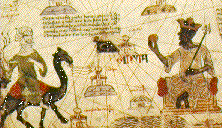

The Sosso king Sumanguru of the Kante dynasty, was the last king of ancient Ghana, had taken over the empire (Or more specifically, what was left of it) and was trying to reestablish the Ghana kingdom. Sumanguru Kante controlled all of the Ghana lands except for Manding. According to one legend, Sumanguru systematically killed off all of the sons but Sundiata, who was frail and weak. Sumanguru made the error of leaving Sundiata alone because of this, and would later live long enough to regret it. Another, more likely story, says that Sumanguru had taken over Manding and the rulers there fled or were killed, for Mandingo messengers found him in Mema and reported what had occured. It was time for Sundiata to reclaim his throne and lands, and the king of Mema gave him a force of troops to return with.
In the oft-cited legend, Sundiata grew stronger and began to rule the Mali kingdom while steadily gaining power and troop strength. It came to pass that in 1235, at the battle of Kirina, Sundiata and Sumanguru met in battle. According to legend, both were sorcerers, and their magic would determine the outcome. Sundiata roared at the troops of King Sumanguru, who were terrified and ran for cover. Sumanguru retaliated, and the heads of eight spirits magically appeared above his own. Unfortunately for Sumanguru, Sundiata had the stronger magic, and the spirits were defeated. Sundiata then aimed an arrow at Sumaguru, and although it only grazed Sumanguru's shoulder, it drained him of all magic, and Sumanguru was defeated. A griot retells what followed:
It was at Kirina that Sundiata and Sumanguru would fight the decisive battle. Sumanguru had numbers and a great magician on his side, but Sundiata regained the services of the griot of the Keita royal family, Balla Fasseke, and also gained the key to Sumanguru's strenght by way of his wife Nana Triban, who was a sister of Sundiata's who was forced to marry Sumanguru. Sumanguru was supposedly invulnerable to iron, but his totem was a white cockspur. This having been delivered to Sundiata, Sumanguru knew his secret was revealed and was not as confident after. According to legend, Sundiata used an arrow tipped with the white cockspur and struck Sumanguru with it, taking his strength away. Sumanguru fled and the Soso were completely routed. Pursuing Sumanguru, Sundiata went to Kulikoro, but failed to capture the fleeing Sosso king. He marched to Sosso and burned it to the ground.(3)
Kirina was an important victory, not only for its military significance, but also because it sealed the alliance and made Sundiata supreme in West Africa. Sundiata continued espansion until all of the territory of Ghana had been absorbed. Each of the chiefs were confirmed in their provinces, but only the chiefs of Mema and Wagadu bore the title of king. Sundiata became the Mansa *king of kings or emperor* of Mali, which at one time was part of Ghana, and established his capital at Niani, on the upper Niger. He set to work on improving agriculture, with soldiers clearing land for farming and planting rice, beans, yams, onions, grain and cotton. This led to Mali becoming a productive farm region, but Sundiata also recognized that the nation's wealth depended on trade, and the wars had disrupted it. With control of the gold mines, Sundiata set to restoring the salt and gold exchange with Niani as the kindgom's trade center (A medieval version of the Chicago Commodities Exchange).
Through the efforts of Sundiata and his successors, Mali became Africa's most powerful kingdom. In addition to gold and salt, Malian control of the copper mines at Takedda and the discovery of new gold sources at Bure made Mali one of the world's economic powerhouses. They were able to move gold easily on the Niger to interested traders, and by the late 1300s, Mali was three times as large as Ghana had been, with its borders reaching the Atlantic in the west, and the middle Niger in the east.
Sundiata was Mali's Genghis Khan, establishing the empire and laying the foundations on which its place in world civilization would be secured. Mali gold was bought by traders and merchants as far away as England and France, as it was the West's primary gold region for centuries to come. Sundiata died around the year 1255.